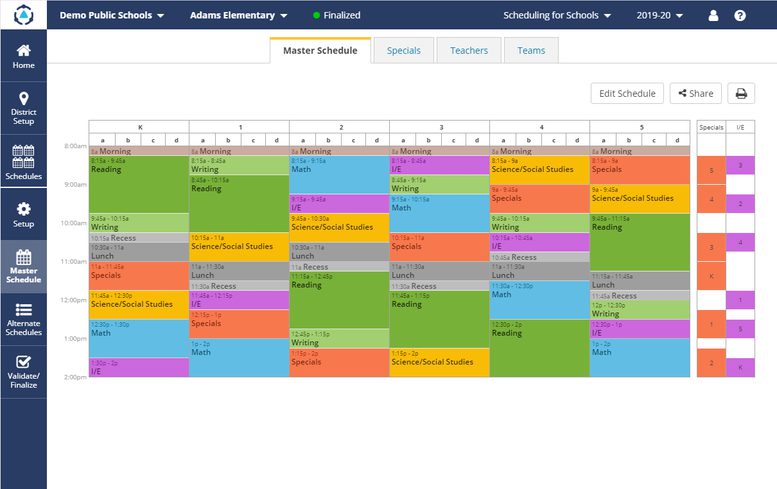To be prepared to pivot when local COVID-19 infection rates change, most districts have created three versions of schedules:
in-person, hybrid, and fully remote. District Management Group has observed that when schools move from hybrid to in-person schedules, the in-person schedules that had been developed are in most cases not applicable, as those schedules had assumed a return to normal. The ongoing need to minimize contacts and to maintain cleaning protocols require the creation of a fourth school schedule — one district we work with has named it the “Full In-Person with Restrictions” schedule.
This particular district began the year in hybrid mode but when planning to shift to full in-person instruction, district leaders realized they had to make changes to the in-person schedules they had originally created. In partnership with DMSchedules, they crafted their Full In-Person with Restrictions schedule.
Here are the five key components to their plan:
1. Stagger intervention blocks and core instruction to safely maximize push-in supports
With a return to in-person instruction, this district’s priority is to serve students who require additional support (e.g. special education, related services, interventions). Under normal circumstances, a key best practice is to schedule intervention blocks and core instruction at the same time across a grade level; students from different classrooms can be regrouped effectively for pull-out supports. But because schools now need to minimize the number of contacts, pulling out and grouping together students from different classrooms is not advisable. Under these circumstances, the reach and impact of teachers and service providers can actually be maximized throughout the day by offsetting core instruction and intervention times, thereby creating greater opportunities for push-in supports. Support providers can move from classroom to classroom, allowing for better adherence to safety guidelines, and allowing these providers to support more students.
2. Preserve staggered arrival and dismissal times
Despite moving to a fully in-person schedule, this district has preserved their hybrid model’s staggered arrival and dismissal times to minimize the number of students in common areas at the same time. This strategy may remain in place as long as social distancing continues to be a priority.
3. Maintain the cleaning routines between specials classes (e.g. art, music, PE)
Frequent cleaning and additional time to sanitize materials between classes is important to support a safe environment for students. In many hybrid models, time has been added between classes that use shared spaces, such as specials, to allow for cleaning and to reduce hallway congestion during transitions. This district is maintaining a minimum of 10 minutes for transitions to support these needs.
4. Clearly identify available spaces and duties for outdoor recess and lunch
In many hybrid schedules, 50% of the school’s students are often in the building at any given time. While some families and students may continue to opt for remote learning, a gradual return to in-person schedules means that the number of students in the building will increase. More students in the building likely means that a school will have to increase the space available in order to accommodate social-distancing guidelines.
In this district, each school has identified three outdoor spaces for recess and two indoor spaces so that two homerooms can each eat lunch concurrently (one eating in the cafeteria and another eating in the classroom). With additional spaces and times scheduled for lunch and recess, greater coordination and clarity are required when scheduling staff duties.
5. Capture what is working well from teachers and students
Flexibility is commonly referenced as a critical requirement to effectively navigate the pandemic. This is especially true when managing multiple schedules and adapting to changing circumstances. As this district thinks through their transition from hybrid to full in-person with restrictions, they have prioritized seeking feedback from staff and students in order to safely meet the needs of their school community.
This district’s experience in preparing for a full in-person with restrictions schedule highlights some practices that may ease the transition while continuing to prioritize the safety of students and staff. Consider how you would move incrementally toward in-person schedules and leverage the lessons of recent remote and hybrid experiences to guide you. Working through these ideas in advance of a need to pivot should help you maintain a healthy and safe learning environment.
Do you have experiences you would like to share to help other districts and schools? Please contact us at support@dmgroupk12.com to share.
If you want to explore any of these ideas further or see how DMSchedules can help you put these practices into action, contact us at scheduling@dmgroupk12.com or visit us at dmschedules.com

About DMSchedules
Create Better School and Staff Schedules Now with DMGroup’s DMSchedules Scheduling Software
Learn more

